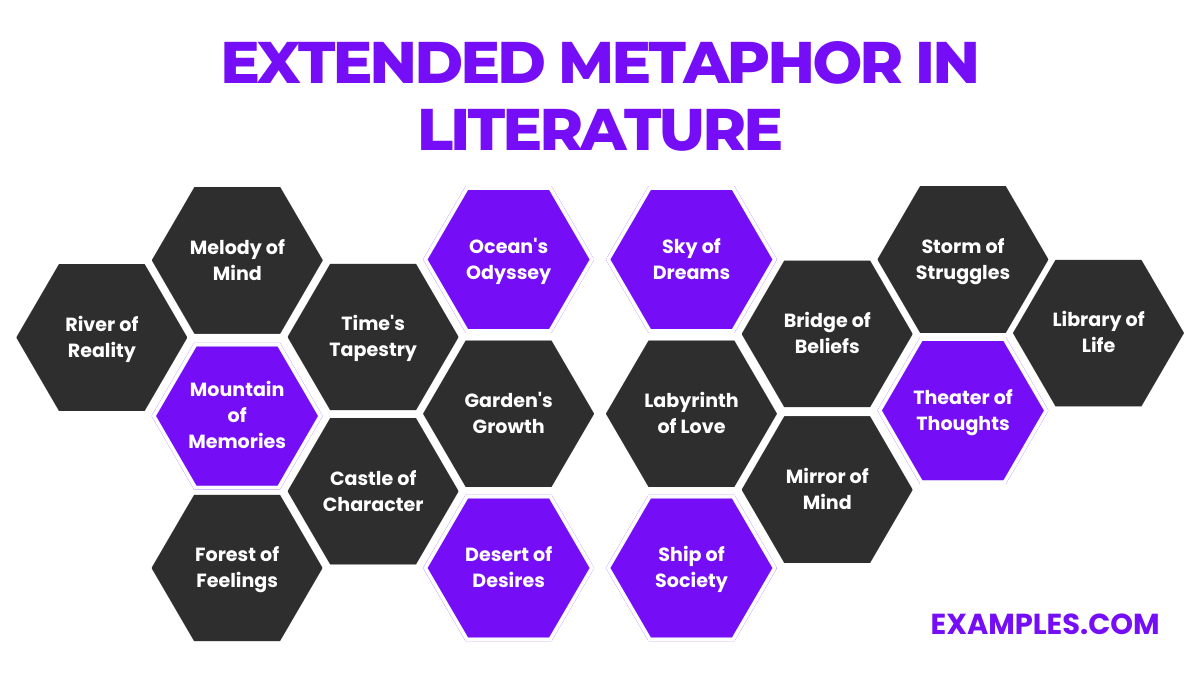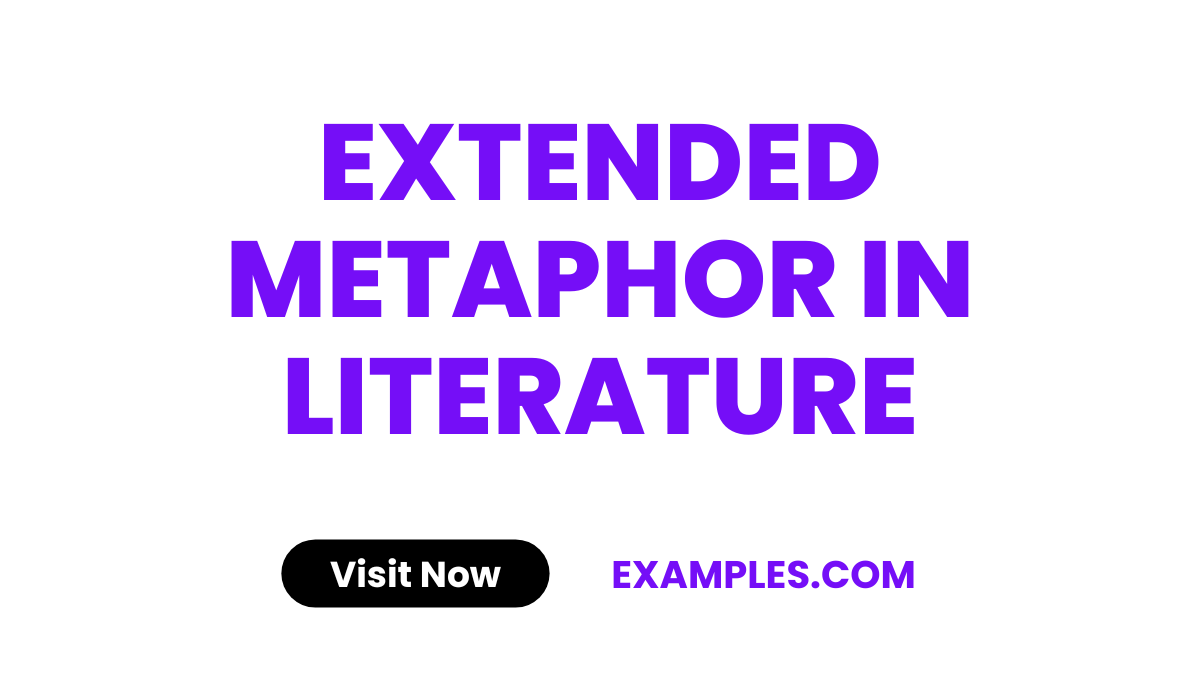59+ Extended Metaphor in Literature Examples
Extended metaphors are a cornerstone of expressive literary writing, allowing authors to weave intricate and meaningful parallels throughout their work. This guide delves into the nuances of crafting extended metaphors, offering practical tips and insights drawn from literary greats. Whether you’re a budding writer or a seasoned author, understanding how to skillfully employ extended metaphors can profoundly enrich your storytelling, adding layers of depth and engaging your readers on a deeper, more symbolic level.
Download Extended Metaphor in Literature PDF
What is the Best Example of Extended Metaphor in Literature

One of the best examples of an extended metaphor in literature is John Donne’s poem “A Valediction: Forbidding Mourning.” In this poem, Donne compares the spiritual and emotional connection he shares with his wife to a pair of compasses. This metaphor extends throughout the poem, symbolizing not only the physical distance between them but also their enduring, unbreakable bond. The compasses represent their separate lives yet illustrate how they remain connected at the core, reflecting the depth and resilience of their relationship. This masterful use of extended metaphor showcases Donne’s ability to convey complex emotions and ideas through powerful and enduring imagery.
Examples of Extended Metaphor in Literature

Extended metaphors in literature are a powerful tool, where a single metaphor stretches across a significant portion of the narrative, deepening the thematic impact. These metaphors create a layered understanding of characters, settings, and themes, allowing writers to weave intricate connections and meanings throughout their work.
- Ocean’s Odyssey – Life as an endless ocean, with each wave a new challenge.
- Garden’s Growth – Existence likened to a garden, each experience a blooming flower.
- Time’s Tapestry – Life depicted as a tapestry, woven with threads of moments.
- Melody of Mind – Thoughts as a symphony, each note a different idea.
- Castle of Character – Personality likened to a castle, with each room a trait.
- River of Reality – Life’s journey as a river, meandering through experiences.
- Mountain of Memories – Past experiences depicted as a mountain range, each peak a memory.
- Forest of Feelings – Emotions as a dense forest, each tree a different feeling.
- Desert of Desires – Desires likened to a desert, vast and endless.
- Sky of Dreams – Aspirations as the sky, limitless and expansive.
- Labyrinth of Love – Love as a complex labyrinth, filled with twists and turns.
- Ship of Society – Society likened to a ship, navigating through cultural seas.
- Bridge of Beliefs – Beliefs as a bridge, connecting different perspectives.
- Mirror of Mind – The mind as a mirror, reflecting thoughts and experiences.
- Storm of Struggles – Life’s challenges depicted as a tempestuous storm.
- Clock of Change – Change likened to a clock, marking the passage of time.
- Theater of Thoughts – Thoughts as actors on the stage of the mind.
- Library of Life – Life depicted as a library, each book a different chapter.
- Pathway of Peace – Inner peace as a serene, winding path.
- Spectrum of Spirit – The human spirit likened to a spectrum of colors.
- Chalice of Choices – Choices depicted as a chalice, filled with possibilities.
- Quilt of Quandaries – Life’s dilemmas as patches in a quilt.
- Orchestra of Opportunity – Opportunities likened to an orchestra, harmonizing chances.
- Puzzle of Purpose – Purpose in life as a complex puzzle to solve.
- Galaxy of Goals – Goals depicted as stars in a vast galaxy.
- Journey of Joy – Joy as a journey, with happiness as the destination.
- Canvas of Courage – Courage likened to a canvas, painted with brave deeds.
- Field of Fears – Fears as a field, with each stalk a worry.
- Tape of Time – Time depicted as a tape, continuously rolling forward.
- Goblet of Growth – Personal growth as a goblet, filled over time.
- Mosaic of Memories – Memories as a mosaic, pieced together from past moments.
- Seasons of the Soul – The soul’s evolution likened to changing seasons.
- Fountain of Feelings – Feelings depicted as a fountain, bubbling and overflowing.
- Garden of Grief – Grief as a garden, where sorrowful flowers bloom.
- Armor of Attitude – Attitude likened to armor, protecting the psyche.
- Tower of Trust – Trust depicted as a tower, built over time.
- River of Regrets – Regrets as a river, flowing with reflections.
- Loom of Life – Life’s complexity woven like fabric on a loom.
- Maze of the Mind – The mind as a maze, filled with thoughts and decisions.
- Forest of Fortunes – Fortunes likened to a forest, dense with destiny.
- Pyramid of Power – Power depicted as a pyramid, structured and hierarchical.
- Sands of Time – Time as sands in an hourglass, slipping away.
- Chain of Challenges – Challenges as links in a chain, interconnected and strong.
- Vault of Values – Values likened to treasures in a vault.
- Waves of Wisdom – Wisdom as ocean waves, coming with experience and age.
- Cathedral of Courage – Courage depicted as a grand cathedral, inspiring and majestic.
- Theater of Time – Time as a theater, with each act a different era.
- Lantern of Learning – Learning likened to a lantern, illuminating the path of knowledge.
- Circus of Circumstances – Circumstances as a circus, unpredictable and varied.
- Balcony of Beliefs – Beliefs depicted as a balcony, overlooking the landscape of thought.
- Symphony of the Senses – The senses as a symphony, each contributing to the experience.
- Playground of Possibilities – Possibilities like a playground, full of potential and fun.
- Island of Identity – Identity as an island, unique and self-contained.
- Mountain of Motivation – Motivation likened to a mountain, challenging and rewarding.
- Labyrinth of Language – Language as a labyrinth, intricate and complex.
- Atlas of Ambition – Ambition depicted as an atlas, mapping the journey to success.
- Gallery of Goals – Goals as artworks in a gallery, each painting a different aspiration.
- Ocean of Opportunity – Opportunity as an endless ocean, vast with potential.
- Network of Nostalgia – Nostalgia like a network, connecting past and present.
- Carousel of Creativity – Creativity as a carousel, colorful and dynamic.
What is a Metaphor in Literature?
A metaphor in literature is a figure of speech that describes an object, person, situation, or action in a way that isn’t literally true but helps explain an idea or make a comparison. Metaphors suggest a similarity between two different things by stating that one thing is another. Unlike similes, which use the words “like” or “as” for comparison, metaphors imply the comparison directly. They are a powerful device in literature, enabling writers to convey deeper meanings, evoke emotions, and provide readers with vivid imagery and understanding.
What is an Example of an Embedded Metaphor?
An embedded metaphor is a metaphor that is integrated into the sentence structure and is less obvious than a direct comparison. It weaves the comparison into the narrative or dialogue, making it a seamless part of the text.
For example, in F. Scott Fitzgerald’s “The Great Gatsby,” the sentence “Gatsby believed in the green light, the orgastic future that year by year recedes before us” contains an embedded metaphor. The ‘green light’ is not just a physical light; it symbolizes Gatsby’s hopes, dreams, and the unreachable, ever-receding nature of these aspirations. This metaphor is embedded within the narrative, subtly offering deep insights into Gatsby’s character and the overarching themes of the novel.
What is an Extended Metaphor Allegory?
An extended metaphor allegory is a narrative in which the characters, actions, and setting represent abstract concepts, apart from the literal meaning of the story. These narratives are extended metaphors, where every element consistently symbolizes another level of meaning. Essentially, an allegory is an extended metaphor that spans the entire story or a significant portion of it.
A classic example is George Orwell’s “Animal Farm,” where the story of a group of farm animals rebelling against their human farmer is an allegory for the Russian Revolution of 1917 and the subsequent Soviet Union. Each character and event in the novel symbolizes a historical figure or event from this period. The extended metaphor here is the comparison of the rise of Soviet communism to the rebellion of the animals, making the complex political narrative more accessible and engaging to readers.
In conclusion, mastering extended metaphors in literature involves crafting comparisons that resonate deeply and span across your narrative. These metaphors enrich storytelling, adding layers of meaning and enhancing reader engagement. Key tips include ensuring consistency in your metaphorical imagery, aligning them with your themes, and weaving them subtly yet powerfully throughout your work to create a lasting impact on your audience.



